When management and market forces changed, the players at this successful, eastern Pennsylvania craft brewery decided it was time for change… And they did – with a little help from their friends.
By: John Holl
This type of meeting usually doesn’t happen in the beer industry.
Jason Miller, Director of Marketing at 31st and Wharton was surprised when the call came in from Neshaminy Creek Brewing Company asking for his input on an upcoming rebrand.
Ten years into its existence, it was time for Neshaminy Creek to step into its next phase.
“Before they committed to what their rebrand was going to look like, they brought us in to go over it all and we were able to sit and give very honest feedback,” says Miller. “We had positive and negative feedback because a lot of the branding was great, but there were some things that might have created issues for a multitude of reasons.”

“The brewery was pumping out a variety of different styles and beers,” says Kyle Park, the brewery’s Director of Marketing. “Over time the identity of the brand expanded and got a little muddled. We were just keeping up, and started to lean into some of these punk rock references and styles that were part of the foundation of the brewery.”
But the brewery has also grown and added new employees and the nature and demographics of the craft drinker have changed as well. Park said it became clear that what had worked in the past for Neshaminy Creek might not be fully representative of what the brewery is today and that a new look might also help with shelf placements as nearly every brewery in the craft space is now canning.
Bringing a distributor partner into the conversation made everyone’s job a bit easier when it comes to sales, marketing, and the future. The rebrand helps drinkers quickly identify the beers by name and style, get the necessary information, like ABV, and make a connection through branding.
The core lineup includes County Line IPA, J.A.W.N. American pale ale, Post Up Pils, UltraCush Hazy IPA, and The Shape of Hops to Come. In addition to UltraCush, the brewery also has a rotating series of hazy Imperial IPAs and others in the space.
There are several new and exciting releases planned for 2024 that appeal to both the engaged craft consumer and the casual but adventurous drinker. This includes The Shape of Haze to Come, an 8.8% hazy double dry-hopped Imperial IPA with Simcoe, Ekuanot, and Mosaic. Post Up Pils will debut in 12-packs in February, perfect for larger gatherings and social events.
Spring is made for Kölsch and Pushing Daisies will offer crackery light grainy malt character, subtle white grape notes, and the earthy bitterness of Herkules and Tettnanger hops.
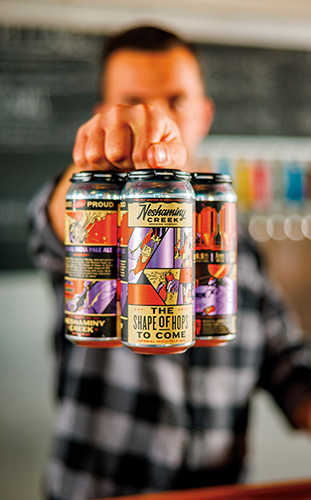
Following the success of Rita’s Fruit Brews line, launched last spring, the brewery will offer a new variety pack in March featuring classic Mango, Peach Ring, and the brand-new Cherry Lemonade flavor.
“Being in tune with the market doesn’t mean we’re going to jump on every single trend that comes by because the trends will shift,” says brewery CEO Jenna Ball. “So, we have to have a good pulse on what has staying power and not what is going to come and go quickly.”
For Ball, the idea behind a rebranding was welcomed. She started working with the company five years ago, first as Chief Financial Officer, coming from the manufacturing industry, not craft beer.
Getting Neshaminy Creek past the usual demographic of 25- to 35-yearold white males was an important step in growing the company and expanding a fan base.
“We needed something that was a little more inviting and inclusive of the true beer drinking community,” she says. “There is a whole world of people out there who enjoy craft beer, so we wanted to expand our marketing to include them.”
It is increasingly difficult to stand out on shelves given all the choices available, so the Neshaminy Creek team knew that to complete a successful rebrand it would need to consult a variety of people and companies, and chief among them was 31st and Wharton.
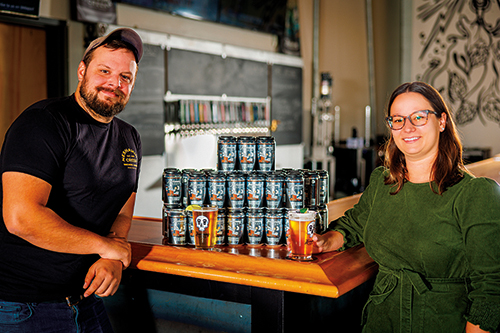
“It’s such a big part of our business as far as distribution and wholesale, so we brought them into the process early on,” says Park. “It was a real collaboration.”
“The Shape of Hops to Come is 31st and Wharton’s highest volume SKU in 16-ounce cans,” says Miller.
31st and Wharton, the craft division of Origlio Beverage, “has a sense of ownership with this and there is a connection that helps when they are out there and selling in the world,” says Park. “It’s a win-win for everyone.”
It’s also the continuation of a long-standing relationship between the brewery and 31st and Wharton.
“We’ve been in the Neshaminy Creek business since Neshaminy Creek sent their first beer out,” says Miller. “I tapped their first keg.”
Park says getting input on areas like alcohol by volume, consumer insights, and label copy helped the whole rebrand pop and achieve efficiency.
For owner Rob Jahn, the whole process was “nerve wracking” but ultimately the right thing. The rebrand was able to bring cohesiveness to the brand while also reflecting the brewery’s maturity and honoring the past. Throughout the process Jahn wanted to make sure that a rebrand would still be recognizable to existing customers but draw in new ones.
“Nothing is ever seamless, but for the most part when we rolled this out at the beginning of a new year, it was well received,” says Jahn. “People knew what was going on and the transfer over was not very difficult. They saw it and knew they could rely on the product.”
Another part of the rebrand was remembering that many of the drinkers who came up with Neshaminy Creek had also matured. It’s not just the brewery employees that are in a different life situation, but the customers as well.
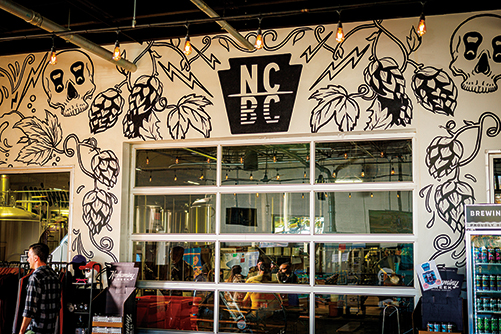
“We were very appreciative to be brought in on the rebrand,” says Miller. “Ultimately, even though they brew the beer, we have to sell the beer.”
The story of Neshaminy Creek Brewing Company is a case study in the rapid evolution of the Philadelphia brewing scene over the last decade and one that highlights how adaption keeps and grows a consumer base.
“The local landscape was wildly different in 2010,” says owner Rob Jahn, “with most of the beer consciousness shared between long-time heavyweights like Victory Brewing Co., Yards, Sly Fox, and Tröegs. There were brewpubs, of course, and a handful of small production facilities, but it seemed like maps were drawn, claims staked.”
When Neshaminy Creek opened in 2012 it started with a 15-barrel brewhouse, a few tanks, and 18,000 square feet in Croydon, PA.
“We were a small brand trying to do production,” says Jahn. “The idea was to get a big enough system and supply the area – specifically Bucks County – as much as possible and grow from there. Here we are 10 or so years later and the ups and downs of the industry have been wild. We’ve seen the good and bad. Now, we are a weird size brewery.”
Size as an Advantage
From the beginning there was a sense to compete and to strive for excellence among themselves, in the industry, and of course with the beer. The release of The Shape of Hops to Come, an Imperial IPA, put them on the radar of rabid beer fans, eager for a hop punch and social media clout.
Even with the hype, Jahn says the brewery never wanted to fall into the realm of only catering to the craft beer nerds. He wanted to be price conscious and to compete against the bigger brands and be competitive overall in the beer space.
“It keeps coming back to our size,” he says. “We’re not small enough to compete with the super hyper niche breweries, and now we’re getting to the place where we can’t compete with super big breweries that can drive price down. So we’re figuring out our place in the market a different way every year.”
Neshaminy Creek is always trying to figure out its own niche and adapt to it. That means being nimble in some areas, tight in others, but always being ready to adapt. That attitude has been the brewery’s biggest advantage in a continuously confusing industry.
Things are moving at such a breakneck pace these days that, “the game has changed by the time you jump on it,” says Ball. “You have to be constantly reinventing and constantly keeping in touch with what the consumers are looking for.”
One approach to stability is having a reliable, familiar, and delicious core lineup of beers. It’s the regular pillars that make a strong foundation, and Neshaminy Creek has built theirs with all beer drinkers in mind.
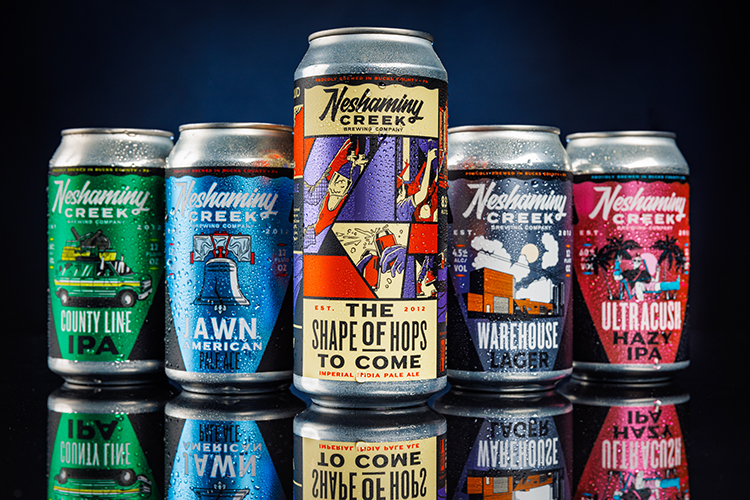
This means looking at the trends and considering more than the general excitement. It’s asking questions about capital investment, the time and cost of retraining staff, looking at branding and more.
“It’s asking, is the juice worth the squeeze,” she says. And over the years the brewery has been really good about considering what is happening around them and deciding whether to take a swing.
“Obviously, hazy IPA became too big not to swing at, but the brewery wanted to take a measured approach to entering the space,” says Park.
“We had built a lot of the brand’s classic styles and especially lagers in the early days of the brewery,” he says. “We were a little hesitant but took the time and realized this was where consumers were moving to.”
Hard seltzer is another good example of the brewery taking a cautious approach, but in the other direction. Jahn says the brewery was watching others get into the space and watching where it was headed. Just because a brewery has the equipment to make hard seltzer does not necessarily mean it should. Ultimately Neshaminy Creek opted not to dive into the category after looking at the time it would take to get the full staff on board and looking at how it could compete – or not – price-wise on the shelves.
“When we take a big shot at something, it’s after carefully considering all those angles and asking: is this something that has some longevity to it before we dive in,” says Ball. “That was our approach with Rita’s.”
A Well-Recognized Collaboration Partner
The COVID-19 pandemic will be remembered by breweries for a lot of reasons. The trouble, the worry, the uncertainty. There are also some who will look back and see that time as a chance to refocus energies where it matters, to plot growth and to get some of the backburner ideas to the forefront.
For Park, a father of young children, inspiration came from downtime. In the spring and summer of 2020 one of the few places his family could go was to the local Rita’s Italian Ice location. It was a chance to be outdoors, away from people, but also getting a sense of normalcy and a treat.
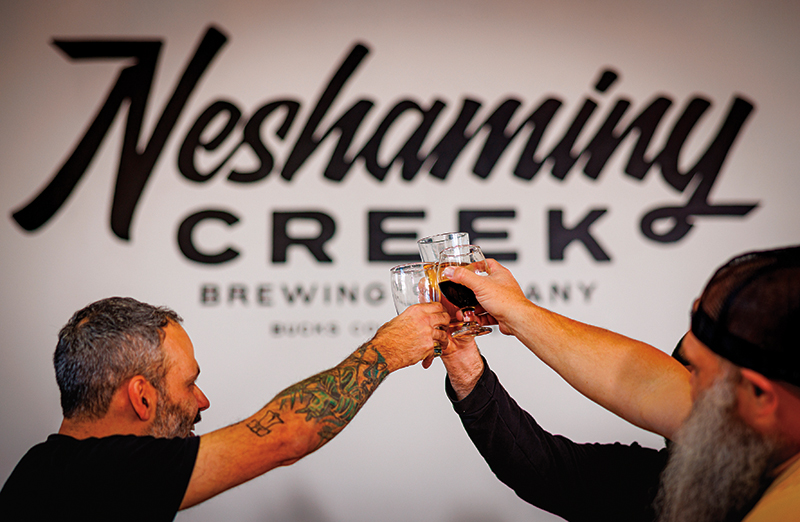
“I don’t know exactly when it happened, but I started to wonder how it would taste if there was alcohol in it,” says Park. “That’d be nice for me and my wife, and we realized there was an opportunity to play around with these flavors.”
In an act of kismet, Park soon realized that Rita’s original location was literally right down the street from the brewery, just five minutes away.
Success did not come quickly. Countless calls and meetings over the course of a year and a half finally began to bear fruit. Park had to spend a lot of time talking with the Rita’s team and getting them comfortable with entering into the alcohol space.
“It has been such a family friendly and focused brand for 40 years, and their marketing team knew right away that it was something to do because they saw brands like Dunkin’ and AriZona, War Heads candies, and others get into the space, but it was a matter of pitching it up the corporate ladder.”
When the green light came, the two sides began looking at the right entry for the collaboration. Mango is Rita’s most popular flavor and that works well in a beer, so it was an easy first choice to release, says Park.
The public’s reaction to the collaboration announcement was the biggest response the brewery had ever received for anything it has done.
“That was reassuring, because we were about to make a lot of it,” says Park.
Rita’s Fruit Brews have become of the brewer’s most popular offerings, and it’s a collaboration that will continue into this summer.
“It’s an authentic connection based on our location,” says Park. “It also brought us a lot of new customers that wouldn’t have normally entertained the thought of buying Neshaminy Creek or any beer to begin with. We saw a lot of new customers in the taproom.”
Looking Forward
As Neshaminy Creek continues to grow within its distribution footprint, Jahn says a focus remains having the right people in the right positions. Team members like Park and Ball have been able to flex their talents inside of their roles with a focus on creativity and sustainability.

The trust in the team is paying dividends, even in uncertain times.
The whipsaw that has been the last decade in craft beer has left a lot of folks dizzy. Jahn still sees the fun, the creativity, the experience that brings joy to consumers.
“We’re not making paper here, we’re making beer,” he says. “We’re making a fun product, an enjoyable product.”
He admits that making enough beer for proper distribution is hard but worth the work.
Jahn has also used the time to reflect on his role as an owner. He’s committed to staying nimble. The owners who are unwilling to adapt or change or listen to the staff are destined to become stagnant and boring, he says. That has never been the Neshaminy Creek way. Right now, the plan for 2024 is to build on the successes they have already locked in while being ready to get flexible if needed.
“The stuff that we do here now is expressive in different ways and I’m shocked when it works. And if it doesn’t work, then we’d go on to the next event, or the next beer, and it doesn’t harm us in some crazy way,” Jahn says. “Being able to express yourself and listen to your people… that’s the way to be successful overall.”
About the Author: John Holl has been covering the beer industry as a reporter and editor for more than 20 years. He is the co-owner & editor of All About Beer magazine. On-air, he hosts the Drink Beer, Think Beer podcast and co-hosts the podcast Steal This Beer. His work has appeared in the New York Times, Wall Street Journal and Washington Post. Holl is the author of several books including The Craft Brewer Cookbook. Photos by Robert L. Mickles
